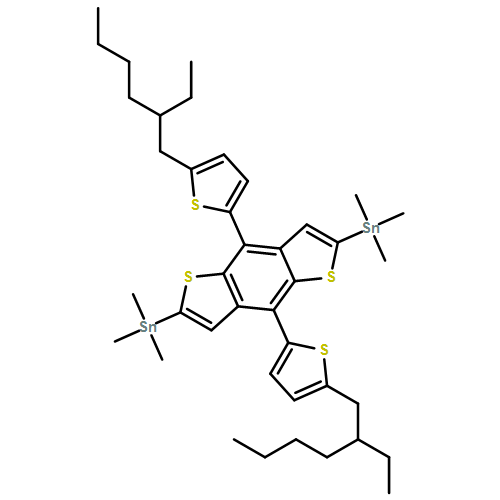Co-reporter: Ailing Tang, Chuanlang Zhan, and Jiannian Yao
pp: 4719
Publication Date(Web):June 11, 2015
DOI: 10.1021/acs.chemmater.5b01350
Small molecules with narrow bandgap of <1.6 eV can harvest the visible and near-infrared solar photons. In this Article, we report a new method to achieve narrow bandgap small molecule donors by using electron-deficient quinoidal methyl-dioxocyano-pyridine (MDP) to induce possible quinoidal resonance structure along the conjugated A−π–D−π–A backbone. Practically, two MDP moieties are covalently linked onto an electron-rich benzodithiophene (BDT) through the oligothiophene (0T–5T) π-bridge. The affording small molecules, namely, nTBM, exhibit broad and strong absorption bands covering the visible and near-infrared region from 400 to 870 nm. The estimated optical bandgap is down to 1.4 eV. The narrow bandgap is associated with the low-lying lowest unoccupied molecular orbital (LUMO) energy level (about −3.7 eV) and the high-lying highest occupied molecular orbital (HOMO) energy level (around −5.1 eV). Density-functional theory calculations reveal that the HOMO and LUMO energy levels, with the increase of the size of the oligothiophene bridge, become localizations in different moieties, i.e., the central electron-donating and the terminal electron-withdrawing units, respectively, which provides necessary driving force for the delocalization of the excited electrons and formation of the quinoidal resonance structure. The quinoidal structure enhances the photoinduced intramolecular charge-transfer, leading to the absorbance enhancement of the low-energy absorption band. With the increase of the size of the oligothiophene from 0 to 5 thienyl units and the change of the direction of the alkyl chains on the bridged thiophene from “outward” to “inward”, the crystalline nature, fibril length, and phase size of the blend films as well as the cell performance are all fine-tuned, also. With the “inward” alkyl chains, the terthiophene bridged molecule is amorphous, while the pentathiophene bridged one is relatively crystalline. Both molecules form nanoscale interpenetrating networks with a phase size of 15–20 nm when blended with PC71BM, showing the higher hole mobility and promising electric performance.
Co-reporter: Jianhua Huang, Chuanlang Zhan, Xin Zhang, Yan Zhao, Zhenhuan Lu, Hui Jia, Bo Jiang, Jian Ye, Shanlin Zhang, Ailing Tang, Yunqi Liu, Qibing Pei, and Jiannian Yao
pp: 2033
Publication Date(Web):February 21, 2013
DOI: 10.1021/am302896u
A solution-processed diketopyrrolopyrrole (DPP)-based small molecule, namely BDT-DPP, with broad absorption and suitable energy levels has been synthesized. The widely used solvents of chloroform (CF) and o-dichlorobenzene (o-DCB) were used as the spin-coating solvent, respectively, and 1,8-diiodooctane (DIO) was used as additive to fabricate efficient photovoltaic devices with BDT-DPP as the donor material and PC71BM as the acceptor material. Devices fabricated from CF exhibit poor fill factor (FF) of 43%, low short-circuit current density (Jsc) of 6.86 mA/cm2, and moderate power conversion efficiency (PCE) of 2.4%, due to rapid evaporation of CF, leading to poor morphology of the active layer. When 0.3% DIO was added, the FF and Jsc were improved to 60% and 8.49 mA/cm2, respectively, because of the better film morphology. Active layer spin-coated from the high-boiling-point solvent of o-DCB shows better phase separation than that from CF, because of the slow drying nature of o-DCB, offering sufficient time for the self-organization of active-layer. Finally, using o-DCB as the parent solvent and 0.7% DIO as the cosolvent, we obtained optimized devices with continuous interpenetrating network films, affording a Jsc of 11.86 mA/cm2, an open-circuit voltage (Voc) of 0.72 V, an FF of 62%, and a PCE of 5.29%. This PCE is, to the best of our knowledge, the highest efficiency reported to date for devices prepared from the solution-processed DPP-based small molecules.Keywords: device optimization; diketopyrrolopyrrole; organic solar cells; solution-processed small molecules;


